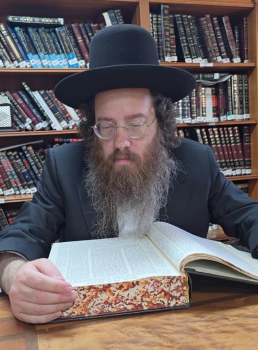Fast of Behab
Question
Answer
Indeed, there exists a somewhat intriguing and lesser-known custom to fast on three separate days following Pesach and Sukkot. The fast is observed on a Monday, Thursday, and again on a Monday. It is called the Behab fast, its name being taken from combining the letters bet , heh , and b et , which refer to Monday, Thursday, and Monday. The fast is not observed immediately following Pesach and Sukkot, but rather, it is pushed off to the month following the holiday, being observed in Iyar and Cheshvan.(1)
The reason that the fast is delayed until the month following the holidays is because it is generally forbidden to fast during the month of Nissan, and fasting should be avoided in Tishrei, as well.(2) Some delay the Behab fasts of Cheshvan until after the seventeenth of the month in order to allow for the fast to be observed on the shortest days of the month.(3) It is observed on Mondays and Thursdays as these are days that are traditionally associated with both judgment and Divine favor. It was on a Monday that Moshe ascended Mount Sinai to receive the Torah and he later descended from it on a Thursday. (4)
There are a number of reasons why the Behab fast was established. Foremost, it serves to atone for any inappropriate behavior that might have taken place over the course of the recent yom tov .(5) This is especially true concerning inappropriate mingling with the opposite sex that might have occurred.(6) It also serves to atone for any forbidden work that one may have performed on Chol Hamoed.(7) Some authorities suggest that the Behab fast is actually therapeutic in nature, intended to strengthen our bodies in preparation for the changing seasons following Pesach and Sukkot.(8)
The Behab fast is also an opportunity to pray that God bless the crops (appropriate following Pesach) and the rains (following Sukkot).(9) Fasting Behab also atones for the severe sin of chillul Hashem (desecration of God’s name) which one might have unintentionally caused at some time.(10) The extensive overeating that is prevalent on yom tov is also considered to be a sin that warrants having to fast Behab. (11) The Behab following Pesach also serves to atone for having possibly eaten chametz over Pesach.(12) It is interesting to note that the Behab fast following Pesach also recalls the true Fast of Esther. This is because the original Fast of Esther was actually a three-day fast which took place in Nissan.(13) Finally, the Behab days serve as an opportunity for general prayer, particularly that God redeem us from the Exile.(14)
The Behab fast is among those that begin at dawn and conclude at nightfall. Some individuals only observe the fast until midday.(15) It seems that this fast is only found among Ashkenazic communities as Sephardic communities never accepted it upon themselves.(16) Even among Ashkenazim the fast is not widely observed and there is legitimate basis for this. It is acknowledged that our generation is physically weaker and more pampered than previous generations, which makes fasting that much more difficult.(17) As the Fast of Behab is only a custom and is not halachically required, one should not fast if doing so will compromise one’s daily productivity.(18) Some have the custom to refrain from eating meat on the Behab fast days.(19)
Those who intend to participate in the fast must formally accept the fast upon themselves at the Mincha prior to the fast. Alternatively, many congregations recite a Mi Shebeirach in the synagogue on the Shabbat before the fast. Answering amen at that time with the intention to fast is deemed sufficient to be included in the fast and one need not do so again at the Mincha prior.(20) Many congregations recite Selichot prayers on the Behab days at some point during the Shacharit service.(21) There is no Behab fast following Shavuot as there is little time over the course of a one-day holiday to commit any sins that would warrant establishing a fast day.(22) Nevertheless, there have been individuals in the past who fasted Behab following Shavuot, as well.(23)
Source
[1] OC 492:1.
[2] Tur, OC 492; Magen Avraham 492:2; Shulchan Aruch Harav , OC 492:2.
[3] Nitei Gavriel , Pesach 43:4.
[4] Tur, Beit Yosef , OC 134; Rema, OC 134:1; Midrash Rabba, Shoftim 5:5. See also Midrash Tanchuma, Bereishit 19:24, cited in Nitei Gavriel .
[5] Tur 492; Mishna Berura 492:1, based on Iyov 1:5.
[6] Tosafot, Kiddushin 81a.
[7] Elya Rabba 492:3.
[8] Levush 492:1, cited in Nitei Gavriel .
[9] Sefer Chassidim 227; Shach, YD 220:31, cited in Nitei Gavriel .
[10] Tur, OC 429.
[11] K ol Bo .
[12] Minhagim Maharam Mirotenberg .
[13] Minhagei Eretz Yisrael (Gellis) 35:1, Minhagei Yisrael (Sperber) 1:26. It is likely that Esther’s three-day fast was not three consecutive days either but rather somewhat like Behab.
[14] Machzor Vitri , Seder Pesach 24.
[15] Cited in Nitei Gavriel , Pesach 42, n. 1.
[16] K af Hachaim , OC 492:8.
[17] Aruch Hashulchan , OC 492:2.
[18] Cited in Nitei Gavriel , Pesach 42, n. 3. It seems that the Rebbes of Chabad would fast Behab, though they encouraged others not to do so.
[19] Nitei Gavriel 43:13.
[20] Magen Avraham 492:3; Davar B’ito , 3 Cheshvan 5769.
[21] OC 566:4.
[22] Beit Yosef , OC 429.
[23] Tamim De’im 177; K ol Bo , Ta’anit 61.
